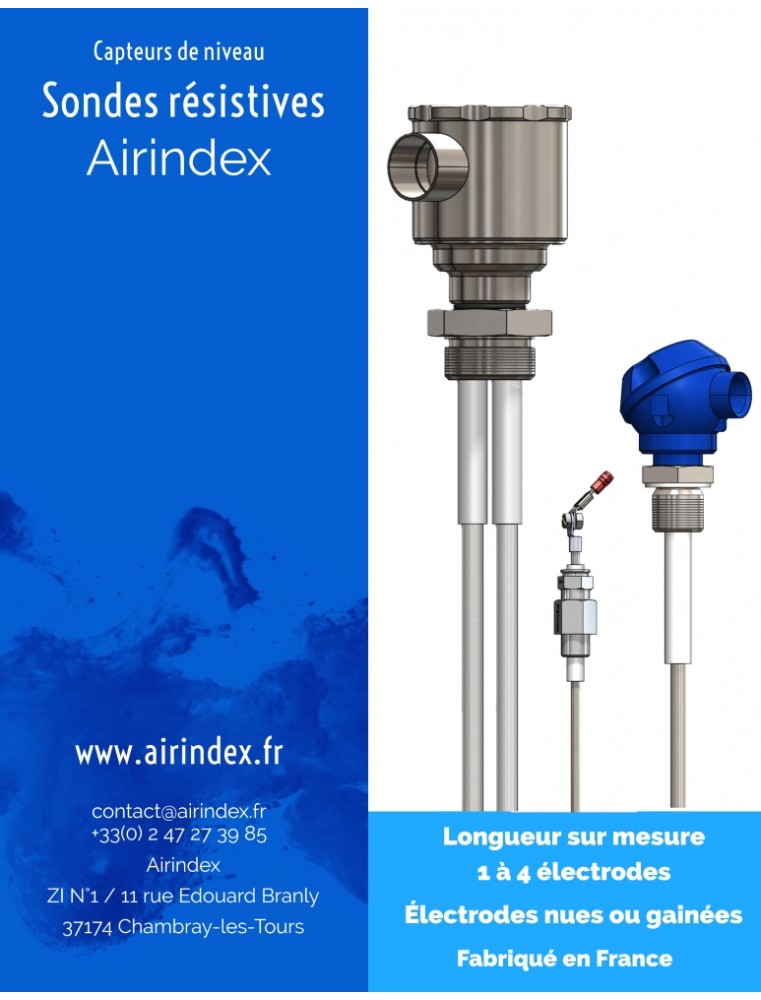- Out-of-Stock


Detection by conductivity provides a simple and economical solution for detecting levels for electrically conductive products, even if their conductivity is low. Conventional applications: High level security, Protection of pumps against dry running, control between a minimum and a maximum. Different combinations of electrodes provide a variety of applications:
A detection chain is composed of two parts:
1. The Electronic Detector:
2. 2. The Probe, matched to the specific features of the installation - temperature, pressure, type of fitting, length, etc. - comprises:
The Electronic Detector delivers an alternating current which crosses the circuit formed by:
When the LIQUID closes the circuit between the electrodes, the current acts on the Detector and its relay output (changeover contact) gives an alarm, control or regulation.
1. The use of two electrodes provides regulation between two points.
2. The use of an AC measuring signal avoids electrolytic phenomena in the product.
3. Reference : If the tank is metal, its mass replaces the reference electrode.
: If the tank wall is insulated, it is essential to use a reference electrode is needed.
1. Détecteurs de Niveaux Conductifs : elles sont détaillées dans les notices spécifiques à chaque appareil.
|
Code notice |
Sortie |
Montage |
Raccordement |
Sensibilité |
|
1 Inverseur |
Armoire sur Rail DIN |
Socle DIN Débrochable |
Fixe |
|
|
1 Inverseur |
Armoire sur Rail DIN |
Socle DIN Débrochable |
Réglable |
|
|
2 Inverseurs |
Armoire sur Rail DIN |
Socle DIN Débrochable |
Réglable + Temporisation |
|
|
4 Inverseurs |
Armoire ou Extérieur |
Bornier Interne |
Réglable |
|
|
2 Inverseur |
Armoire ou Extérieur |
Bornier Interne |
Fixe |
|
|
1 Inverseur |
Armoire ou Extérieur |
Bornier Interne |
Fixe |
|
|
AQUALARM Détecteur de présence d'Eau au Sol |
||||
2. Sondes et Electrodes Conductives : elles sont détaillées dans les notices spécifiques à chaque appareil.
|
Code notice |
Désignation |
Fixation |
Tiges |
|
Sonde Multi-Electrodes |
Raccord G1" ou G2" |
Rigide(s) ou à Câble(s) |
|
|
RL6 Nouveauté |
Sonde Multi-Electrodes |
Raccord PVC/INOX et CLAMP/SMS |
Rigide Isolée PVC ou PTFE |
|
Sonde Multi-Electrodes |
Bride PVC |
Tige(s) Rigide(s) |
|
|
Sonde Simple |
Raccord Clamp |
||
|
Electrode TRIPLE |
Raccord G1/2, en PVC |
Tiges Nues |
|
|
Electrode Simple |
Câbles - pour Puits ou Forages |
||
|
Electrode Simple |
Raccord G1/4 en PTFE (A11FV) ou R1/4 en Inox (A11FVX) |
||
|
Electrode Simple |
Raccord G1/2 (A11RL) ou raccord G3/8 (A11TL) |
||
|
Sonde Simple |
Raccord G1/2 en Inox |
Tige Rigide (A11W) ou Câble (A11Y) |
|
Sous réserve de modification sans préavis